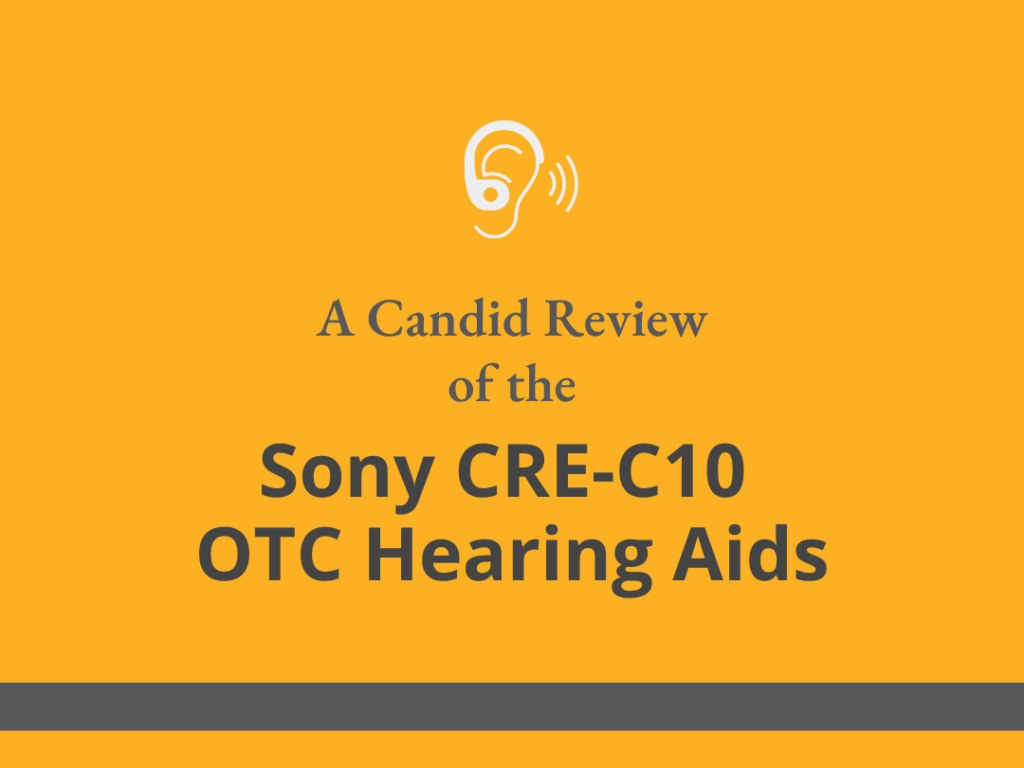In recent months, the hearing healthcare world and news media have been abuzz with information about over-the-counter (OTC) hearing aids like the new Sony CRE-C10 OTC hearing aids. While not hearing the buzz could mean you need hearing aids yourself, there’s also a chance that you simply don’t know what over-the-counter hearing aids are all about. Whichever the case may be, we can help!
At Advanced Hearing Group, we are committed to helping people of all ages and walks of life hear better. And when new hearing technology becomes available, we’re anxious to learn more about it ourselves so we can help our clients make the best decisions about their own hearing health. Today, we’re going to break down what over-the-counter hearing aids are and evaluate the pros and cons of the new Sony CRE-C10 OTC hearing aids.
What Are Over-the-Counter Hearing Aids?
You’re probably very familiar with over-the-counter medications – drugs that can be purchased at your local pharmacy or retail store without a doctor’s prescription. Over-the-counter hearing aids work in a similar fashion. No prescription or hearing test is required to buy OTC hearing aids either locally or online.
In 2017, bipartisan hearing aid legislation was passed by Congress in an effort to make hearing loss treatment more readily available and accessible to everyone. However, it wasn’t until August of 2022 that the Food and Drug Administration (FDA) released its guidelines regarding the implementation of this legislation. Now, we’re beginning to see over-the-counter hearing devices like the Sony CRE-C10s hit retail shelves, and it’s time to see exactly how beneficial they will be.
Pros and Cons of the Sony CRE-C10 Self-Fitting OTC Hearing Aids
Rather than relying on the news media or someone’s personal opinion of these new devices, we decided to put them to the test ourselves. One of our audiologists, Dr. Gary Johnson, did a complete unboxing of the Sony CRE-C10 Self-Fitting OTC hearing aids. Watch the full video below or keep reading to learn more about the advantages and disadvantages he discovered.
Pros of the Sony CRE-C10 OTC Hearing Aids:
- Packaging – These devices come in an aesthetically pleasing package that clearly shows what’s inside.
- Carrying case – A hard carrying case is included. While most people with hearing loss wear their hearing aids all day long, this case can come in handy for protecting your devices when you do need to take them out.
- Markings – Each of the hearing aids in the set is marked ‘right’ or ‘left.’ This makes it easy to get the right hearing aid in the correct ear.
- Fitting sleeves – A couple of different fitting sleeves are included in the package so the hearing aids can be adjusted to improve comfort based on ear canal size.
- Instructions – A complete user guide with instructions on how to use the devices as well as how to set up the hearing aid app is included.
- Cleaning tools – A cleaning cloth and cleaning brush are provided to help with hearing aid maintenance.
- Cost – The Sony CRE-C10 OTC hearing aids are currently sold for approximately $1,000 per set, a significant difference from prescription hearing aids that typically cost several thousands of dollars.
Cons of the Sony CRE-C10 OTC Hearing Aids:
- Size – These devices are not as discreet as some prescription hearing aids, especially for individuals with small ear canals.
- Connectivity – While the Sony CRE-C10s do have bluetooth technology that enables them to connect to the set-up app, they aren’t able to connect to other bluetooth-enabled devices for audio streaming.
- Hearing test – During the set-up process, the user goes through a simplified hearing test to help identify preferred settings. However, this is not as detailed and thorough as a hearing test with an audiologist or other hearing professional.
SONY CRE-C10 Self-Fit Hearing Aids vs. Prescription Hearing Aids
With all of the pros listed above, how do over-the-counter hearing aids such as the Sony CRE-C10s compare to traditional hearing aids prescribed by our audiologists? That’s exactly what Dr. Gary evaluated during this exercise. After unboxing the devices, the hearing aids were set up on a real patient and then compared to that patient’s prescription hearing aids.
Using real ear measurement, Dr. Gary was able to measure the output of each set of hearing aids inside the ear canal. Here’s what he discovered …
When compared to the Sony CRE-C10 OTC hearing aids, prescription hearing aids:
- Provided a better fit inside the ear canal.
- Were more closely programmed to the patient’s specific type and severity of hearing loss.
- Offered better sharpness and clarity.
- Showed better hearing capability.
Are Over-the-Counter Hearing Aids Worth the Money?
While the Sony CRE-C10 OTC hearing aids didn’t perform as highly as prescription hearing aids in terms of helping our patient hear better, their relatively low cost could make hearing loss treatment more affordable and accessible for some people.
It should be noted, however, that all OTC hearing aids are meant for only those people who have mild to moderate hearing loss. Additionally, while these devices offer some short term advantages (i.e. upfront money savings), they may not offer enough long term benefits to justify the cost. In fact, Dr. Gary estimates that many people who start out with OTC hearing aids will end up turning to prescription devices within a year.
Given the information above, you may be able to make a decision about what’s best for your own hearing health. If you have questions or concerns, however, we recommend that you schedule an appointment with an audiologist. After all, your hearing is vital to your health and when you can hear better, you can often live better, too!


